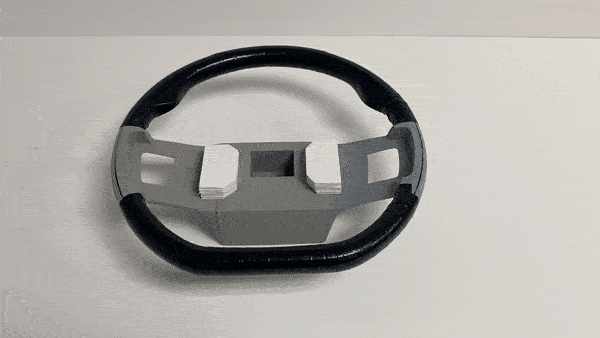Testing Automotive HMI is challenging due to the variety of inputs available to the driver, including the steering wheel, infotainment module, gauge cluster, voice commands, and more. The instrument pictured here was designed and built to integrate with Unreal Engine, allowing for the simulation of real-world designs and scenarios within a simulator environment.
The steering wheel is constructed from 3D-printed segments, which are epoxied together and wrapped with black tape. The center hole is designed to accommodate a standard diameter steering column shaft, with the wheel being a full 1:1 scale replica of a production steering wheel. The center also features a cutout designed to house a programmable deck, which serves as the second major component of the system.
The second major component of the instrument is a programmable control deck, which offers infinite configurability. In this application, buttons are embedded in a three-by-three layout, allowing for flexible input options. The entire system is controlled by an Arduino, providing customizable control over the instrument's functionality.
Decks can be easily swapped out, allowing for quick testing of different configurations to suit various design needs and scenarios.
By utilizing freely available programming assets, one can leverage Unreal Engine to facilitate communication between 4D objects and interfaces, enabling dynamic interaction within the simulation environment.
Conclusion
In conclusion, this Arduino-controlled steering wheel testbed offers a versatile and scalable solution for testing automotive HMI designs. By combining a customizable, 3D-printed steering wheel with an infinitely configurable control deck, all integrated with Unreal Engine, this setup enables precise simulations of real-world scenarios. The ease of swapping out control decks further enhances its flexibility, making it a valuable tool for iterating and refining different configurations. Ultimately, this testbed provides an effective platform for exploring the complexities of automotive human-machine interfaces in a controlled, simulated environment.





